Hans Cummings's Blog, page 10
October 28, 2015
REVIEW – Humanity Gone: After the Plague by Derek Deremer and Dean Culver
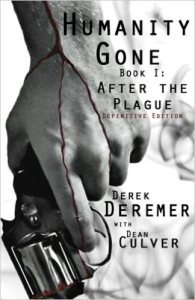 Humanity Gone: After the Plague is engaging post-apocalyptic fiction, but it is not without problems.
Humanity Gone: After the Plague is engaging post-apocalyptic fiction, but it is not without problems.
First the good. The characters are interesting and well-rounded. The story moves along at a good pace and pulled me in within a few pages. I found myself rooting for their survival, and I didn’t feel any of them acted particularly idiotic to move the plot forward, though they do make bad decisions from time to time, just like normal people do, and these are just young adult in very stressful circumstances. Most everyone over the age of 19 dies of a mysterious plague in this book, which seems suspiciously specific, particularly since there is nothing special about turning 20, but that didn’t bother me because in this type of story, something must act as the apocalyptic catalyst and usually isn’t important to the plot itself. However, since there is at least one exception to the everyone-over-19 plague, if the authors expand on it in future books, it better be good. As it is, in this book, the explanation is not necessary.
Humanity Gone: After the Plague is written in a shifting first-person, present tense. An unusual choice, and I don’t believe I’ve read first-person present ever before in novel-length fiction. Normally, shifting viewpoint first person drives me batty to the point where I can’t read it, but since each chapter is titled with the name of the point-of-view character (ala Game of Thrones), I did not get lost, nor did I mind it. The present tense did feel a little awkward at times, and I wonder how much the feel of the story would’ve changed had it been written in past tense, as most novels are. It’s not a big deal, just a point of curiosity for me.
Now, I did notice a LOT of formatting errors, and this is another instance where I really want to be able to rate half-stars, because 3 stars seems a little harsh. I found them distracting enough that rounding up to 4 stars seems overly generous, though. Now, many readers may not notice the errors, and I don’t know if they were caused by the e-book conversion process or if they’re the fault of the authors (or whoever they had do the page layout). Having such obvious formatting errors distract me caused me to notice more spelling & syntax errors than I probably would’ve noticed. No matter how many editing/proofreading passes a manuscript gets, it’s virtually impossible to catch all typos, and I’ll bet most people won’t notice them anyway. The formatting, though, that really bothered me because it made the book look unprofessional.
Still, if you’re not bothered by that and you want some entertaining post-apocalyptic fiction, then you certainly could do worse. I was in the mood for a story of that nature, and this did not disappoint. I’m definitely going to add book 2 to my reading list.


October 21, 2015
Character Preview: Qaliah
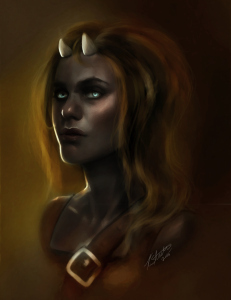 In my last character Sneak Peak, we looked at The Golden Slayer. Also making her debut in Scars of the Sundering: Lament, is the fiendling Qaliah.
In my last character Sneak Peak, we looked at The Golden Slayer. Also making her debut in Scars of the Sundering: Lament, is the fiendling Qaliah.
Pancras encounters Qaliah at the Arcane University in Muncifer. She already knows Gisella and is currently working off a debt to the Archmage by acting as a sort of court jester. She goes out of her way to be annoying in this capacity, as one might if they know their punishment is needlessly humiliating. Qaliah ditches the jester outfit and accompanies Gisella and Pancras on their journey once her debt is paid.
Her fiendish heritage is evident in her jet-black skin, red eyes, and horns, and Qaliah keenly feels the distrustful stares of most people she encounters. She’s used to fending for herself and defends herself with sharp knives and sharp tongue. She’s not sure why she should care about the challenges facing Pancras and Gisella, yet she sees an opportunity to do something worthwhile when she encounters the minotaur necromancer.
Lament will be available early 2016. Scars of the Sundering, book 1: Malediction is available in print and on Kindle from Amazon.com.


October 19, 2015
REVIEW – Fargoer: A Viking Fantasy Adventure by Petteri Hannila (Author) and Anthony Farnden (Editor)
 I received a copy of this novel for review purposes. When I first heard “Finnish Fantasy,” I was excited because I’ve been on a sort of Norse kick lately. I dropped the non-fiction book I was currently reading and dove right into Fargoer: A Viking Fantasy Adventure
I received a copy of this novel for review purposes. When I first heard “Finnish Fantasy,” I was excited because I’ve been on a sort of Norse kick lately. I dropped the non-fiction book I was currently reading and dove right into Fargoer: A Viking Fantasy Adventure Fargoer.
Fargoer.
For a translated book, I was pleasantly surprised how well almost everything was translated. Often, there are passages and idioms that get lost a bit in translation, and there were a few places where I initially scratched my head, but upon a second reading, I realized that my confusion came more from my reading speed than any problems with the translation. If I didn’t know the novel was translated from Finnish, I would not have assumed it was a translation.
The story is written almost as a collection of slice-of-life vignettes from the point of view of a woman of the Kainu tribe, Vierra. She’s strong and stubborn to a fault, protective of the ones she loves. It starts as an almost textbook “Hero’s Journey” story, but goes off those rails fairly quickly, and that’s a good thing. There’s nothing wrong with the heroic journey, but it’s been done. Unfortunately, Vierra is the only character we really get to know very well. We’re often introduced to characters important to Vierra and don’t get to see her relationship grow with them before they’re taken out of the story. This lack of development for the secondary and tertiary characters made it hard to feel anything for Vierra’s many hardships, even though I did feel sorry for her that she had to endure so much. I wanted to see more of her relationship with her cousin. I wanted to learn more about the Kainu people. Some of these problems probably could’ve been alleviated with a longer narrative.
Despite the story feeling rushed, I did enjoy it. I had sympathy for the main character and wanted to see her succeed. I am only tangentially familiar with Finnish myth and folklore, so I don’t know how much of what I read was based in that, and how much was the author’s original creation. I knew of Meilikki and the Great Hunt, Loviatar, & Illmater, the latter two of which are NOT in this story, but that’s about it. I was intrigued by this world and would like to read more novels set there.


October 14, 2015
REVIEW – The Dresden Files, book 2: Fool Moon by Jim Butcher
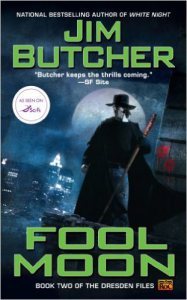 Fool Moon (The Dresden Files, Book 2)
Fool Moon (The Dresden Files, Book 2) Fool Moon is the second novel in the Dresden Files series. It took me longer to finish it than it really should have. Real Life™ intruded, and the fact that several people were telling me that this was the worst of the Dresden File books probably didn’t help.
Fool Moon is the second novel in the Dresden Files series. It took me longer to finish it than it really should have. Real Life™ intruded, and the fact that several people were telling me that this was the worst of the Dresden File books probably didn’t help.
I can see why people think this book is weaker than the first Dresden Files book. Harry makes several well-intentioned, but boneheaded decisions which cause no small amount of complications that would’ve been avoided if he had just been up front with someone. It’s nice, however, that he gets called out on this sort of thing, and I think it’s just part of his character development. I also understand that some of the characterizations are shaky in the first several books and these problems all go away once Jim Butcher finds his stride and decides what the Dresden Files are going to be.
Fool Moon can be summed up as Harry Dresden vs. werewolves. I liked that the story featured several different types of werewolves, as well as the continued exploration of the negative side of using the more primal emotions (anger, fear, lust) to fuel magic, and indeed, as a motivation.
I can’t really get into more detail on my feelings about this because of the breaks I took; all I can say is I never felt like reading it was a chore, I never felt like I wasn’t connecting with the characters. I just got distracted by life, and it’s causing me difficulty in being detailed with this review. I enjoyed Fool Moon, and I have to say, if this is the WORST Dresden Files has to offer, then getting through the rest of this series is going to be very enjoyable indeed.


October 12, 2015
REVIEW – The Dresden Files, book 1: Storm Front by Jim Butcher
 True Confession Time: Until last year, I had not read any Dresden Files books.
True Confession Time: Until last year, I had not read any Dresden Files books.
Sure, I was familiar with the property from my involvement in the gaming industry. I just never got around to reading it (and I do wonder where I was when these books came out; I would’ve read the heck out of these).
Storm Front is the first book in the vaunted Dresden Files urban fantasy series. It reminds me of a hard-boiled film noir detective story, if the bad guys were vampires, wizards, and werewolves instead of corrupt bankers and gangsters. (Of course, in Dresden Files, there’s nothing stopping the gangster from being a werewolf or vampire!) The first-person narration style strengthens this perception. Harry Dresden is a down-on-his-luck wizard, the only one listed in the Chicago phone book. He’s likable, despite a character flaw which is a personal pet peeve of mine: poor communication skills (he often withholds information for someone’s own good which ends up causing him much trouble and many misunderstandings… if ONLY he’d told so-and-so the truth… etc.). It remains to be see how much the character grows out of this unfortunate habit in subsequent novels.
In short, Harry Dresden is called upon by the police to help them solve a murder which clearly has supernatural origins. In the meantime, he’s hired to privately investigate a woman’s missing husband case. To give the resolution would be spoilerific, so I’ll just say it’s entertaining, the world is engaging and believable (assuming you buy into the whole urban fantasy schtick to begin with), and the characters are likeable when they’re supposed to be, and hissable when they’re bad. The book was shorter than I expected (I’ve gotten used to doorstoppers by default for anything remotely labeled as fantasy) and read very quickly. Butcher gives you just enough information to “get” the world & characters he is creating without overloading you on unnecessary details. It is an approach I appreciate since reading should be enjoyable, not a chore.
If you’re interested in reading urban fantasy and have not yet begun exploring this rich and entertaining genre, you would be well-advised to start here.
My review of book 2: Fool Moon will be up in a few days. See you then!


October 7, 2015
Character Preview: The Golden Slayer
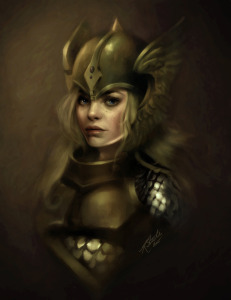
Art by Kathryn Steele
It’s not a spoiler to reveal that our heroes reach Muncifer in Lament, book 2 of Scars of the Sundering. A new locale means new characters, and two women enter Pancras’s life and change the course of his future.
The first is The Golden Slayer, Gisella Vibekedottir, a warrior from the Four Watches. She serves the Arcane University as a Slayer, the organization that hunts down renegade wizards and brings them to justice (or more often: brings justice to them).
Unlike her fellow Watch brothers and sisters, Gisella is a devotee of Aurora, the goddess of love and beauty. She bucked tradition as a youth to set herself apart from her sister Alysha, a powerful sorceress, and the tainted (in her mind) legacy of her ancestors. Plus, being the only member of her immediate family who was not magically inclined, Gisella sought her own identity, apart from what others expected of her.
The stern, merciless persona of The Golden Slayer masks the mead-loving, thoughtful Gisella’s true personality. She lets her hair down, literally and figuratively around friends, but they are few and far between in Muncifer, a city torn between its honorable Duke and its vitriolic, power-hungry Archmage.
Lament will be available early 2016. Scars of the Sundering, book 1: Malediction is available in print and on Kindle from Amazon.com.


October 5, 2015
REVIEW – Who on Earth is Tom Baker? An Autobiography
 A bittersweet, poignant, and often funny look at the life of the man who occupied the shoes of a certain Time Lord in the mid to late 1970s. You can tell that Tom Baker is a very intelligent man, yet, despite his popularity as The Doctor, has almost crippling self-esteem issues. He admits as much and lays the blame for most of his misfortunes in life solely at his own feet, though I would argue his upbringing in war-torn Liverpool is more to blame to that than his own shortcomings. Whether his misfortunes are the result of bad decisions or bad circumstance, one can’t help but feel sympathy for this man who has brought so much entertainment to so many for so long.
A bittersweet, poignant, and often funny look at the life of the man who occupied the shoes of a certain Time Lord in the mid to late 1970s. You can tell that Tom Baker is a very intelligent man, yet, despite his popularity as The Doctor, has almost crippling self-esteem issues. He admits as much and lays the blame for most of his misfortunes in life solely at his own feet, though I would argue his upbringing in war-torn Liverpool is more to blame to that than his own shortcomings. Whether his misfortunes are the result of bad decisions or bad circumstance, one can’t help but feel sympathy for this man who has brought so much entertainment to so many for so long.
I’m reminded of a poem, by Robert Burns, I believe:
Behind every clown is a sad man.
Beneath every smile there are tears.
In front of all women there are stop signs.
In the heart of all hero’s are fears.
Sometimes smiles and tears mingle.
My wish is all the time it’s that way.
Every woman and clown put all obstacles down,
Just turn around from sadness, each day.
The above two verses are simply brilliant.
I cannot think of what else I can say.
But this poem needs a third verse,
Sometimes it’s a curse.
But I smile as I am writing, it’s O.K.
If you’re looking for a behind-the-scenes look at Doctor Who, look elsewhere. It was a short 7-year period in this man’s life and largely seems to have been an escape from reality for him, a reality he perceives as being a string of failures, both before and after his time as The Doctor.
Who is Tom Baker? He was The Doctor and The Doctor was him. He remains a gifted, captivating story-teller.


September 28, 2015
REVIEW – Star Wars: A New Dawn by John Jackson Miller
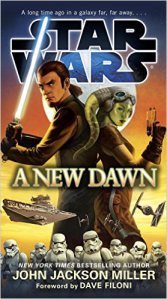 They say brevity is the soul of wit, but despite the brief nature of this review, it’s not particular witty. I think I originally wrote it on my Kindle (hence the brevity; virtual keyboards are difficult to write on).
They say brevity is the soul of wit, but despite the brief nature of this review, it’s not particular witty. I think I originally wrote it on my Kindle (hence the brevity; virtual keyboards are difficult to write on).
A New Dawn is an action-packed look at the origin of the partnership between Hera Syndulla and Kanan Jarrus (of Disney XD’s “Star Wars Rebels” fame). While independently working against an Imperial scheme to mine a world in a manner which makes strip mining look environmentally friendly, Hera and Kanan meet and agree to work together to stop the Empire’s plan.
It gives a good look at Kanan’s background, and the source of his self-doubt, particularly his status as a reluctant former Jedi and rebel. It also develops Hera more than the animated series has thus far, shedding light on her motivations and dedication to the budding Rebellion.


September 21, 2015
REVIEW – Iron Edda: Sveidsdottir by Tracy Barnett
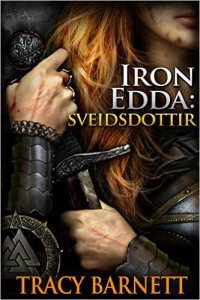 I bought this not knowing quite what to expect. I backed the Iron Edda Kickstarter, so I knew there would be bound bones of giants, but that’s about it.
I bought this not knowing quite what to expect. I backed the Iron Edda Kickstarter, so I knew there would be bound bones of giants, but that’s about it.
Iron Edda: Sveidsdottir primarily follows a young-woman born with the power of a Valkyrie who then gains the power of having the bones and spirit of a centuries-dead giant bound to her of course, with great power comes great responsibility and it is this lesson our protagonist must learn as she sets out to prevent Ragnarok.
The descriptions are evocative and the action moves along at a good clip. The characters are interesting and well-developed with ambitions, dreams, and flaws we can relate to. It’s a good, quick read set in an interesting fantasy world that is at once new and original yet not unfamiliar.
My only issue with Iron Edda: Sveidsdottir is something I think is a personal hang up. It’s written in a shifting viewpoint 1st person present tense. The only other time I’ve tried to read a shifting viewpoint first person, I found it extremely difficult because it would take me several sentences to figure out which character’s eyes I was looking through. Tracy Barnett helpfully labels each chapter with the name of the viewpoint character, so that helped. It’s a narrative style I’m not used to and I’m not sure I particularly like, but some quick research shows it seems to be a fairly common, modern style for this type of fiction. Like I said, it’s a personal hang up, and if it doesn’t bother you, then you’ll zip right through this story.
Iron Edda: Sveidsdottir is an excellent freshman effort from Tracy Barnett and I look forward to seeing where the story goes from here.


Review – Iron Edda: Sveidsdottir by Tracy Barnett
 I bought this not knowing quite what to expect. I backed the Iron Edda Kickstarter, so I knew there would be bound bones of giants, but that’s about it.
I bought this not knowing quite what to expect. I backed the Iron Edda Kickstarter, so I knew there would be bound bones of giants, but that’s about it.
Iron Edda: Sveidsdottir primarily follows a young-woman born with the power of a Valkyrie who then gains the power of having the bones and spirit of a centuries-dead giant bound to her of course, with great power comes great responsibility and it is this lesson our protagonist must learn as she sets out to prevent Ragnarok.
The descriptions are evocative and the action moves along at a good clip. The characters are interesting and well-developed with ambitions, dreams, and flaws we can relate to. It’s a good, quick read set in an interesting fantasy world that is at once new and original yet not unfamiliar.
My only issue with Iron Edda: Sveidsdottir is something I think is a personal hang up. It’s written in a shifting viewpoint 1st person present tense. The only other time I’ve tried to read a shifting viewpoint first person, I found it extremely difficult because it would take me several sentences to figure out which character’s eyes I was looking through. Tracy Barnett helpfully labels each chapter with the name of the viewpoint character, so that helped. It’s a narrative style I’m not used to and I’m not sure I particularly like, but some quick research shows it seems to be a fairly common, modern style for this type of fiction. Like I said, it’s a personal hang up, and if it doesn’t bother you, then you’ll zip right through this story.
Iron Edda: Sveidsdottir is an excellent freshman effort from Tracy Barnett and I look forward to seeing where the story goes from here.





